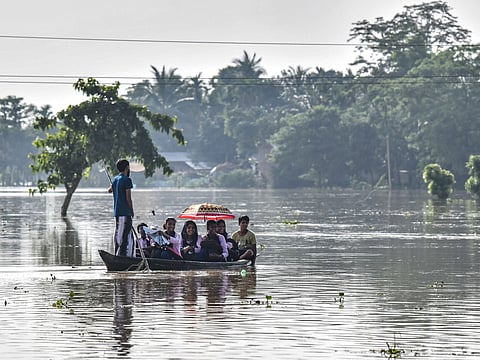Floods in northeastern India: Assam, Sikkim, and Manipur struggle with devastation
Floods in Assam reach alarming levels, affecting over 700,000 people amid monsoon rains

Northeastern India is facing an ongoing crisis as continuous monsoon rains have led to catastrophic flooding across Assam, Sikkim, and Manipur, displacing thousands of residents and causing extensive damage to infrastructure, homes, and crops. As heavy rainfall persists, authorities are warning of more severe flooding in the coming days, particularly in vulnerable regions.
In Assam, the situation has reached alarming levels. Over 700,000 people have been directly affected by the floods, with districts like Kaziranga, Barpeta, and Dhemaji reporting severe damage. The Brahmaputra River and its tributaries have breached embankments, submerging vast swathes of land and leaving many villages isolated. Homes, roads, and agricultural fields are submerged, and the floodwaters have caused extensive harm to livestock, amplifying the economic and social toll on local communities.
Meanwhile, in Sikkim and Manipur, rivers such as the Teesta and the Imphal are flowing dangerously close to danger levels. In Sikkim, areas like Gangtok and nearby towns are grappling with landslides triggered by the constant rain. While the floods have displaced many in Manipur, it is the agricultural destruction that has farmers most worried, with crops such as rice, maize, and vegetables being washed away by the rising floodwaters.
Authorities in all three states have issued red alerts as the rainfall intensity shows no signs of relenting. The Indian Meteorological Department (IMD) has predicted that the deluge could persist for several more days, exacerbating the flooding risks. River levels continue to rise, particularly in flood-prone districts, and many local rivers have breached embankments, forcing evacuations and disrupting road networks. Major highways have been cut off, making transportation increasingly difficult.
In response to the unfolding disaster, rescue operations have been ramped up across the region. The Indian Army, National Disaster Response Force (NDRF), and local authorities are deploying specialized teams to rescue stranded people, evacuate flood-hit areas, and distribute emergency relief supplies. Helicopters and boats are being used to reach the most inaccessible places, while makeshift shelters are being set up for displaced families.
Medical teams are working around the clock to provide critical care, prevent the spread of waterborne diseases, and address injuries caused by floods. However, challenges continue to mount, with many affected areas still unreachable due to submerged infrastructure, collapsed bridges, and blocked roads.
Sign up for the Daily Briefing
Get the latest news and updates straight to your inbox



